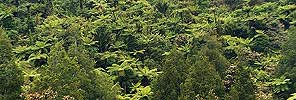 Letters
Letters
[an error occurred while processing the directive]
Spotted Cycads
Rev. Geoffrey F. Squire
About four years ago I bought two almost identical
Cycad revoluta in pots from a plant sale in Cornwall. One was planted
out at the base of a wall and the other was planted in a 9"
pot so that it could be given shelter in the winter.
The one in open ground has grown slightly faster than the one in
a pot; otherwise, they have behaved in a very similar manner. For
the first two years they remained exactly as they were when purchased,
but then the leaves on both started to show yellow spots, as thought
they had been near weed-killer spray. Gradually all the leaves turned
yellow and then looked completely dead for some months. Then, late
last summer, they both showed signs of growth and about a dozen
fresh, green, and much larger leaves emerged quite rapidly.
They remained like that until late summer this year, but now both
are again showing signs of yellow spotting. This can not be due
to frost, or to salt-laden winds, or to weed-killers, and they are
unlikely to have suffered drought. The one in a pot has been kept
drier in winter than the one in the open ground, so being too wet
would also not appear to be the cause. Both are kept in semi-shade
conditions.
Is this spotting, yellowing, and dying back of the leaves something
that happens naturally before new growth begins, or is some other
factor likely to be involved?
Yucca gloriosa and their varieties also seem to be behaving in a
strange manner in recent years. Many of them seem to be flowing
in mid-winter (with four in full bloom on New Years Day), while
Cordyline Australis flower so profusely that the weight of the flowers/seeds
break off some branches.
In various parts of the Westcountry, Phormium, Osteospermum, Arum
Lilies, Agapanthus, Mesembryantheum, Carpobrotus edulis, and a few
Cordyline australis are growing completely wild, as escapees from
cultivation, and there is at least one place where Opuntia (Prickly
Pear) cactus are growing on cliffs. Are these things connected with
the seemingly unusual behavior of some species in cultivation, or
are they quite normal? Some put it down to global warming, but I
am rather skeptical. It was only 13 years ago, in February 1987,
that the Southwest experienced its lowest temperatures since records
began. Severe frost caused damage to or even killed outright things
that had been growing for 100 years or more. I would enjoy hearing
what others think.
Conservation Through Cultivation Update
Réne
Coativy




1. Dracena undivisa
2. Rhopalostylis population
3. Rhopalostylis sapida Akaroa
4. R. sapida with Cyathea meddularis
In response to Andrew Cartwright‘s interesting
article ‚Conservation Through Cultivation‘ I would like
to add a few words first on the conservation status of Rhopalostylis
sapida on the New Zealand mainland. I am just back from New Zealand
where I saw hundreds of thousands of them although their natural
territory (which is really everywhere on the two islands) has been
dramatically reduced. This forest clearance was begun by the first
European settlers and has never stopped even today, especially in
the Nelson to Picton area where entire mountainous forests are being
cleared for pine planting. Rhopalostylis sapida seem not to be in
danger except in a few remote spots where the remaining population
is in so low in numbers that its long term survival is questionable.
In the case of the Akaroa (Banks Peninsula-Christchurch-Southern
Island) remnant population the whole area was cleared for sheep
grazing and some hundred mature palms are confined in a very scenic
gully with a stream along which they grow. I must report that there
are many seedlings and small palms to 5 feet under the thick canopy
though strangely enough there is no size in between this and the
adults which would mean a non regeneration gap of at least 35 to
40 years. Why? The area has been recently fenced and therefore some
predators like sheep and goats are no longer able to enter the area
and eat the young plants. There is no other Rhopalostylis sapida
population for hundreds of miles away in other areas like Paparoa
National Park in the southern island and along the Heritage Trail
between Stratford and Taumarunui in the northern island or in the
Kauri National Park in the far north. Rhopalostylis sapida, together
with tree ferns (Cyathea cooperi and C. medullaris depending on
the latitude) is still the major component of the forest and the
landscape. The result is truly outstanding and unforgettable and
I strongly recommend anyone visiting New Zealand to see them for
themselves.
As far as the reintroduction of palms is concerned there are excellent
examples nearby us and those who attended the last excellent EPS
meeting will agree with me that the best example is the naturalization
of Trachycarpus fortunei in the Swiss-Italian Ticino along Lake
Maggiore where they grow by the million in stunning settings. Also
we should bear in mind that a lot of amateurs are already growing
threatened palms in more favourable climates i.e. Madagascan palms
in California, Cuban palms in Florida, Andean palms in New Zealand
etc. Closer to us in southern Europe endangered palms that must
normally be nurtured indoors, thrive outdoors even on the French
Riviera. Brahea aculeata, Chamadorea glaucifolia, C. klotschiana
and C. hooperiana, C. microspadix and C. radicalis, Phoenix theophrastii,
Rhopalostylis baueri and R. sapida among those you cite. The situation
is not desperate, although we must remain alert.

Readers Comments:
(No comments yet. Be the first to add a comment to
this article!)
|
 |
[an error occurred while processing the directive] |
